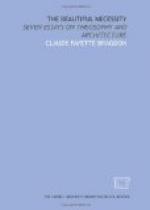[Illustration 71]
Nevertheless, when all is said, it is easy to exaggerate the importance of this matter of geometrical proportion. The designer who seeks the ultimate secret of architectural harmony in mathematics rather than in the trained eye, is following the wrong road to success. A happy inspiration is worth all the formulae in the world—if it be really happy, the artist will probably find that he has “followed the rules without knowing them.” Even while formulating concepts of art, the author must reiterate Schopenhauer’s dictum that the concept is unfruitful in art. The mathematical analysis of spatial beauty is an interesting study, and a useful one to the artist; but it can never take the place of the creative faculty, it can only supplement, restrain, direct it. The study of proportion is to the architect what the study of harmony is to a musician—it helps his genius adequately to express itself.
VI
THE ARITHMETIC OF BEAUTY
Although architecture is based primarily upon geometry, it is possible to express all spatial relations numerically: for arithmetic, not geometry, is the universal science of quantity. The relation of masses one to another—of voids to solids, and of heights and lengths to widths—forms ratios; and when such ratios are simple and harmonious, architecture may be said, in Walter Pater’s famous phrase, to “aspire towards the condition of music.” The trained eye, and not an arithmetical formula, determines what is, and what is not, beautiful proportion. Nevertheless the fact that the eye instinctively rejects certain proportions as unpleasing, and accepts others as satisfactory, is an indication of the existence of laws of space, based upon number, not unlike those which govern musical harmony. The secret of the deep reasonableness of such selection by the senses lies hidden in the very nature of number itself, for number is the invisible thread on which the worlds are strung—the universe abstractly symbolized.




